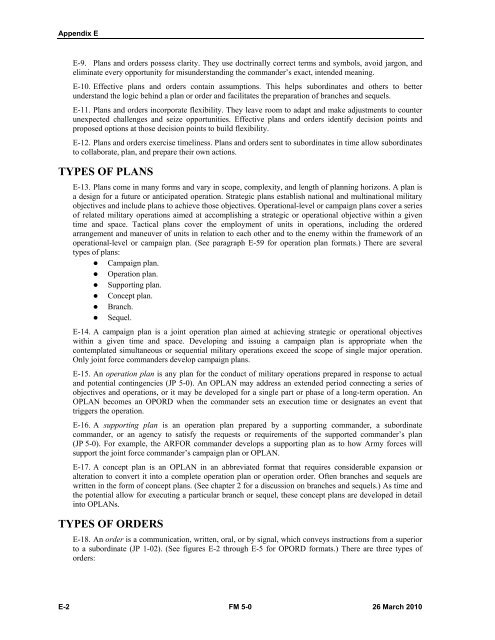FM 5-0, The Operations Process - Federation of American Scientists
FM 5-0, The Operations Process - Federation of American Scientists
FM 5-0, The Operations Process - Federation of American Scientists
You also want an ePaper? Increase the reach of your titles
YUMPU automatically turns print PDFs into web optimized ePapers that Google loves.
Appendix E<br />
E-9. Plans and orders possess clarity. <strong>The</strong>y use doctrinally correct terms and symbols, avoid jargon, and<br />
eliminate every opportunity for misunderstanding the commander’s exact, intended meaning.<br />
E-10. Effective plans and orders contain assumptions. This helps subordinates and others to better<br />
understand the logic behind a plan or order and facilitates the preparation <strong>of</strong> branches and sequels.<br />
E-11. Plans and orders incorporate flexibility. <strong>The</strong>y leave room to adapt and make adjustments to counter<br />
unexpected challenges and seize opportunities. Effective plans and orders identify decision points and<br />
proposed options at those decision points to build flexibility.<br />
E-12. Plans and orders exercise timeliness. Plans and orders sent to subordinates in time allow subordinates<br />
to collaborate, plan, and prepare their own actions.<br />
TYPES OF PLANS<br />
E-13. Plans come in many forms and vary in scope, complexity, and length <strong>of</strong> planning horizons. A plan is<br />
a design for a future or anticipated operation. Strategic plans establish national and multinational military<br />
objectives and include plans to achieve those objectives. Operational-level or campaign plans cover a series<br />
<strong>of</strong> related military operations aimed at accomplishing a strategic or operational objective within a given<br />
time and space. Tactical plans cover the employment <strong>of</strong> units in operations, including the ordered<br />
arrangement and maneuver <strong>of</strong> units in relation to each other and to the enemy within the framework <strong>of</strong> an<br />
operational-level or campaign plan. (See paragraph E-59 for operation plan formats.) <strong>The</strong>re are several<br />
types <strong>of</strong> plans:<br />
• Campaign plan.<br />
• Operation plan.<br />
• Supporting plan.<br />
• Concept plan.<br />
• Branch.<br />
• Sequel.<br />
E-14. A campaign plan is a joint operation plan aimed at achieving strategic or operational objectives<br />
within a given time and space. Developing and issuing a campaign plan is appropriate when the<br />
contemplated simultaneous or sequential military operations exceed the scope <strong>of</strong> single major operation.<br />
Only joint force commanders develop campaign plans.<br />
E-15. An operation plan is any plan for the conduct <strong>of</strong> military operations prepared in response to actual<br />
and potential contingencies (JP 5-0). An OPLAN may address an extended period connecting a series <strong>of</strong><br />
objectives and operations, or it may be developed for a single part or phase <strong>of</strong> a long-term operation. An<br />
OPLAN becomes an OPORD when the commander sets an execution time or designates an event that<br />
triggers the operation.<br />
E-16. A supporting plan is an operation plan prepared by a supporting commander, a subordinate<br />
commander, or an agency to satisfy the requests or requirements <strong>of</strong> the supported commander’s plan<br />
(JP 5-0). For example, the ARFOR commander develops a supporting plan as to how Army forces will<br />
support the joint force commander’s campaign plan or OPLAN.<br />
E-17. A concept plan is an OPLAN in an abbreviated format that requires considerable expansion or<br />
alteration to convert it into a complete operation plan or operation order. Often branches and sequels are<br />
written in the form <strong>of</strong> concept plans. (See chapter 2 for a discussion on branches and sequels.) As time and<br />
the potential allow for executing a particular branch or sequel, these concept plans are developed in detail<br />
into OPLANs.<br />
TYPES OF ORDERS<br />
E-18. An order is a communication, written, oral, or by signal, which conveys instructions from a superior<br />
to a subordinate (JP 1-02). (See figures E-2 through E-5 for OPORD formats.) <strong>The</strong>re are three types <strong>of</strong><br />
orders:<br />
E-2 <strong>FM</strong> 5-0 26 March 2010















